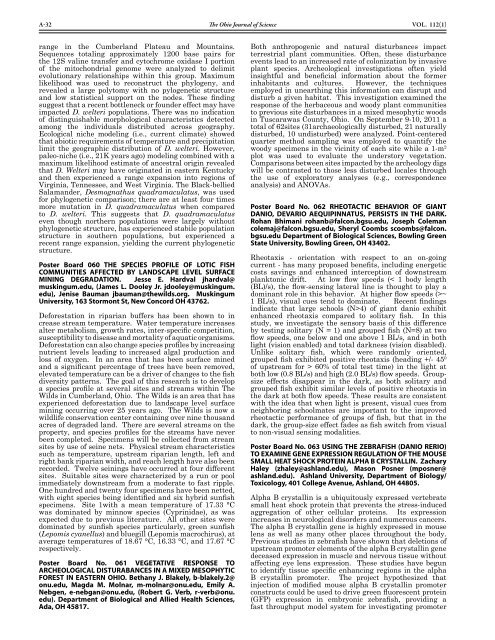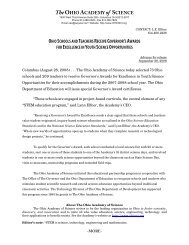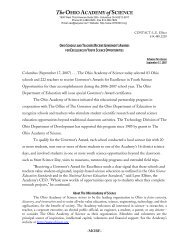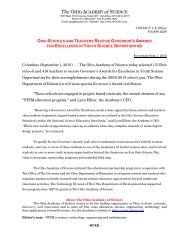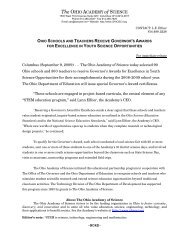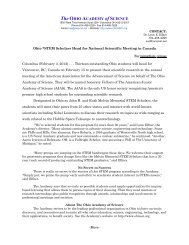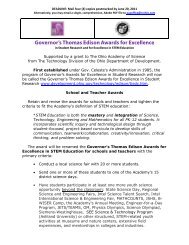The Ohio Journal of - The Ohio Academy of Science
The Ohio Journal of - The Ohio Academy of Science
The Ohio Journal of - The Ohio Academy of Science
Create successful ePaper yourself
Turn your PDF publications into a flip-book with our unique Google optimized e-Paper software.
A-32 <strong>The</strong> <strong>Ohio</strong> <strong>Journal</strong> <strong>of</strong> <strong>Science</strong><br />
Vol. 112(1)<br />
range in the Cumberland Plateau and Mountains.<br />
Sequences totaling approximately 1200 base pairs for<br />
the 12S valine transfer and cytochrome oxidase I portion<br />
<strong>of</strong> the mitochondrial genome were analyzed to delimit<br />
evolutionary relationships within this group. Maximum<br />
likelihood was used to reconstruct the phylogeny, and<br />
revealed a large polytomy with no pylogenetic structure<br />
and low statistical support on the nodes. <strong>The</strong>se finding<br />
suggest that a recent bottleneck or founder effect may have<br />
impacted D. welteri populations. <strong>The</strong>re was no indication<br />
<strong>of</strong> distinguishable morphological characteristics detected<br />
among the individuals distributed across geography.<br />
Ecological niche modeling (i.e., current climate) showed<br />
that abiotic requirements <strong>of</strong> temperature and precipitation<br />
limit the geographic distribution <strong>of</strong> D. welteri. However,<br />
paleo-niche (i.e., 21K years ago) modeling combined with a<br />
maximum likelihood estimate <strong>of</strong> ancestral origin revealed<br />
that D. Welteri may have originated in eastern Kentucky<br />
and then experienced a range expansion into regions <strong>of</strong><br />
Virginia, Tennessee, and West Virginia. <strong>The</strong> Black-bellied<br />
Salamander, Desmognathus quadramaculatus, was used<br />
for phylogenetic comparison; there are at least four times<br />
more mutation in D. quadramaculatus when compared<br />
to D. welteri. This suggests that D. quadramaculatus<br />
even though northern populations were largely without<br />
phylogenetic structure, has experienced stabile population<br />
structure in southern populations, but experienced a<br />
recent range expansion, yielding the current phylogenetic<br />
structure.<br />
Poster Board 060 THE SPECIES PROFILE OF LOTIC FISH<br />
COMMUNITIES AFFECTED BY LANDSCAPE LEVEL SURFACE<br />
MINING DEGRADATION. Jesse E. Hardval jhardval@<br />
muskingum.edu, (James L. Dooley Jr. jdooley@muskingum.<br />
edu), Jenise Bauman jbauman@thewilds.org. Muskingum<br />
University, 163 Stormont St, New Concord OH 43762.<br />
Deforestation in riparian buffers has been shown to in<br />
crease stream temperature. Water temperature increases<br />
alter metabolism, growth rates, inter-specific competition,<br />
susceptibility to disease and mortality <strong>of</strong> aquatic organisms.<br />
Deforestation can also change species pr<strong>of</strong>iles by increasing<br />
nutrient levels leading to increased algal production and<br />
loss <strong>of</strong> oxygen. In an area that has been surface mined<br />
and a significant percentage <strong>of</strong> trees have been removed,<br />
elevated temperature can be a driver <strong>of</strong> changes to the fish<br />
diversity patterns. <strong>The</strong> goal <strong>of</strong> this research is to develop<br />
a species pr<strong>of</strong>ile at several sites and streams within <strong>The</strong><br />
Wilds in Cumberland, <strong>Ohio</strong>. <strong>The</strong> Wilds is an area that has<br />
experienced deforestation due to landscape level surface<br />
mining occurring over 25 years ago. <strong>The</strong> Wilds is now a<br />
wildlife conservation center containing over nine thousand<br />
acres <strong>of</strong> degraded land. <strong>The</strong>re are several streams on the<br />
property, and species pr<strong>of</strong>iles for the streams have never<br />
been completed. Specimens will be collected from stream<br />
sites by use <strong>of</strong> seine nets. Physical stream characteristics<br />
such as temperature, upstream riparian length, left and<br />
right bank riparian width, and reach length have also been<br />
recorded. Twelve seinings have occurred at four different<br />
sites. Suitable sites were characterized by a run or pool<br />
immediately downstream from a moderate to fast ripple.<br />
One hundred and twenty four specimens have been netted,<br />
with eight species being identified and six hybrid sunfish<br />
specimens. Site 1with a mean temperature <strong>of</strong> 17.33 °C<br />
was dominated by minnow species (Cyprinidae), as was<br />
expected due to previous literature. All other sites were<br />
dominated by sunfish species particularly, green sunfish<br />
(Lepomis cyanellus) and bluegill (Lepomis macrochirus), at<br />
average temperatures <strong>of</strong> 18.67 °C, 16.33 °C, and 17.67 °C<br />
respectively.<br />
Poster Board No. 061 VEGETATIVE RESPONSE TO<br />
ARCHEOLOGICAL DISTURABANCES IN A MIXED MESOPHYTIC<br />
FOREST IN EASTERN OHIO. Bethany J. Blakely, b-blakely.2@<br />
onu.edu, Magda M. Molnar, m-molnar@onu.edu, Emily A.<br />
Nebgen, e-nebgan@onu.edu, (Robert G. Verb, r-verb@onu.<br />
edu). Department <strong>of</strong> Biological and Allied Health <strong>Science</strong>s,<br />
Ada, OH 45817.<br />
Both anthropogenic and natural disturbances impact<br />
terrestrial plant communities. Often, these disturbance<br />
events lead to an increased rate <strong>of</strong> colonization by invasive<br />
plant species. Archeological investigations <strong>of</strong>ten yield<br />
insightful and beneficial information about the former<br />
inhabitants and cultures. However, the techniques<br />
employed in unearthing this information can disrupt and<br />
disturb a given habitat. This investigation examined the<br />
response <strong>of</strong> the herbaceous and woody plant communities<br />
to previous site disturbances in a mixed mesophytic woods<br />
in Tuscarawas County, <strong>Ohio</strong>. On September 9-10, 2011 a<br />
total <strong>of</strong> 62sites (31archaeologically disturbed, 21 naturally<br />
disturbed, 10 undisturbed) were analyzed. Point-centered<br />
quarter method sampling was employed to quantify the<br />
woody specimens in the vicinity <strong>of</strong> each site while a 1-m 2<br />
plot was used to evaluate the understory vegetation.<br />
Comparisons between sites impacted by the archeology digs<br />
will be contrasted to those less disturbed locales through<br />
the use <strong>of</strong> exploratory analyses (e.g., correspondence<br />
analysis) and ANOVAs.<br />
Poster Board No. 062 RHEOTACTIC BEHAVIOR OF GIANT<br />
DANIO, DEVARIO AEQUIPINNATUS, PERSISTS IN THE DARK.<br />
Rohan Bhimani rohanb@falcon.bgsu.edu, Joseph Coleman<br />
colemaj@falcon.bgsu.edu, Sheryl Coombs scoombs@falcon.<br />
bgsu.edu Department <strong>of</strong> Biological <strong>Science</strong>s, Bowling Green<br />
State University, Bowling Green, OH 43402.<br />
Rheotaxis - orientation with respect to an on-going<br />
current - has many proposed benefits, including energetic<br />
costs savings and enhanced interception <strong>of</strong> downstream<br />
planktonic drift. At low flow speeds (< 1 body length<br />
(BL)/s), the flow-sensing lateral line is thought to play a<br />
dominant role in this behavior. At higher flow speeds (>~<br />
1 BL/s), visual cues tend to dominate. Recent findings<br />
indicate that large schools (N>4) <strong>of</strong> giant danio exhibit<br />
enhanced rheotaxis compared to solitary fish. In this<br />
study, we investigate the sensory basis <strong>of</strong> this difference<br />
by testing solitary (N = 1) and grouped fish (N=8) at two<br />
flow speeds, one below and one above 1 BL/s, and in both<br />
light (vision enabled) and total darkness (vision disabled).<br />
Unlike solitary fish, which were randomly oriented,<br />
grouped fish exhibited positive rheotaxis (heading +/- 45 0<br />
<strong>of</strong> upstream for > 60% <strong>of</strong> total test time) in the light at<br />
both low (0.8 BL/s) and high (2.0 BL/s) flow speeds. Groupsize<br />
effects disappear in the dark, as both solitary and<br />
grouped fish exhibit similar levels <strong>of</strong> positive rheotaxis in<br />
the dark at both flow speeds. <strong>The</strong>se results are consistent<br />
with the idea that when light is present, visual cues from<br />
neighboring schoolmates are important to the improved<br />
rheotactic performance <strong>of</strong> groups <strong>of</strong> fish, but that in the<br />
dark, the group-size effect fades as fish switch from visual<br />
to non-visual sensing modalities.<br />
Poster Board No. 063 USING THE zEBRAFISH (DANIO RERIO)<br />
TO EXAMINE GENE EXPRESSION REGULATION OF THE MOUSE<br />
SMALL HEAT SHOCK PROTEIN ALPHA B CRYSTALLIN. zachary<br />
Haley (zhaley@ashland.edu), Mason Posner (mposner@<br />
ashland.edu). Ashland University, Department <strong>of</strong> Biology/<br />
Toxicology, 401 College Avenue, Ashland, OH 44805.<br />
Alpha B crystallin is a ubiquitously expressed vertebrate<br />
small heat shock protein that prevents the stress-induced<br />
aggregation <strong>of</strong> other cellular proteins. Its expression<br />
increases in neurological disorders and numerous cancers.<br />
<strong>The</strong> alpha B crystallin gene is highly expressed in mouse<br />
lens as well as many other places throughout the body.<br />
Previous studies in zebrafish have shown that deletions <strong>of</strong><br />
upstream promoter elements <strong>of</strong> the alpha B crystallin gene<br />
deceased expression in muscle and nervous tissue without<br />
affecting eye lens expression. <strong>The</strong>se studies have begun<br />
to identify tissue specific enhancing regions in the alpha<br />
B crystallin promoter. <strong>The</strong> project hypothesized that<br />
injection <strong>of</strong> modified mouse alpha B crystallin promoter<br />
constructs could be used to drive green fluorescent protein<br />
(GFP) expression in embryonic zebrafish, providing a<br />
fast throughput model system for investigating promoter


